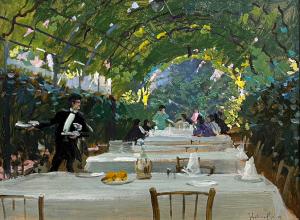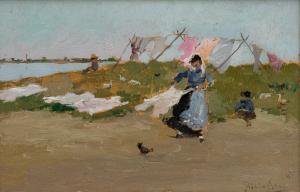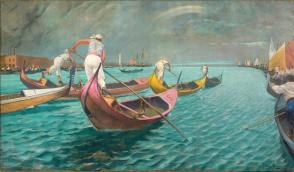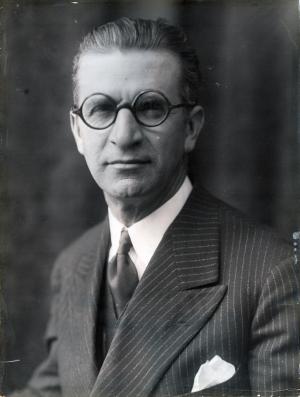 Italico Brass enjoyed significant success as a painter during his lifetime. As a young man, he participated in international exhibitions and was noted for the originality of his pictorial style. We have information of his affirmation in the art market and important acquisitions by private collectors and museums and galleries. There is no history of twentieth-century painting in the Veneto and Italy that does not dedicate some pages and biographical and bibliographical information about him. Even in the city’s collective imagination (and beyond), Brass’s name is commonly present; people are aware of him. His last significant solo exhibition in Venice was dedicated to him in the first post-war Biennale, in 1948, since which there has practically been silence. Sporadically, small quantities of his works have appeared at auction and in specialised markets. His home town, Gorizia, dedicated an extensive exhibition to him in 1991 in the Castle.
Italico Brass enjoyed significant success as a painter during his lifetime. As a young man, he participated in international exhibitions and was noted for the originality of his pictorial style. We have information of his affirmation in the art market and important acquisitions by private collectors and museums and galleries. There is no history of twentieth-century painting in the Veneto and Italy that does not dedicate some pages and biographical and bibliographical information about him. Even in the city’s collective imagination (and beyond), Brass’s name is commonly present; people are aware of him. His last significant solo exhibition in Venice was dedicated to him in the first post-war Biennale, in 1948, since which there has practically been silence. Sporadically, small quantities of his works have appeared at auction and in specialised markets. His home town, Gorizia, dedicated an extensive exhibition to him in 1991 in the Castle.
We believe that eighty years after his death it is opportune, indeed necessary, to re-read and critically reposition this figure as an intellectual and cultural player in the city. Italico, in fact, considered a significant representative of twentieth-century Venetian painting, did not belong to any school, current, secession or other, but as the critics say, “belonged to himself”. This circumstance is all the more interesting in view of the presence in the city not only of the Biennale but of modernist and avant-garde movements of great renown and recognised quality.
 But there is also a further motivation that made us look to Italico Brass as an indispensable historical and critical point of reference: the testimony and image that he gives us of a city that at the time was still not only highly liveable but exemplary despite its uniqueness. An anti-rhetorical, everyday, authentic place, festive in its rites and processions, a city of ‘normal’ people in a ‘special’ city. There is no nostalgia in Brass’s Venice because Italico looked to the present and aimed at the future, as is right for anyone who sets himself the problem of preserving the signs and forms of a living yet fragile community.
But there is also a further motivation that made us look to Italico Brass as an indispensable historical and critical point of reference: the testimony and image that he gives us of a city that at the time was still not only highly liveable but exemplary despite its uniqueness. An anti-rhetorical, everyday, authentic place, festive in its rites and processions, a city of ‘normal’ people in a ‘special’ city. There is no nostalgia in Brass’s Venice because Italico looked to the present and aimed at the future, as is right for anyone who sets himself the problem of preserving the signs and forms of a living yet fragile community.
 What are the special characteristics of Brass’s painting? His birth in Gorizia, in what was then a peripheral town of the Austro-Hungarian Empire, was accompanied by a strong sense of ‘Italianism’ cultivated in his family, which made no secret of sharing the aspirations of the irredentist groups for union with the young Kingdom of Italy. This dual cultural and political matrix gave the young Italico considerable freedom, removing him from the excessive cultural and historical conditioning of the worn Venetian and Veneto artistic tradition. His educational path is simple: at the age of seventeen he enrolled at the Academy of Fine Arts in Munich and, after just one year, he arrived in Paris, where he remained for at least seven intense years, fundamental years for his human and artistic development. He attended the Ecole des Beaux Arts and the Académie Julian: true incubators of art pompier talent as well as of modernity itself. But it is above all his participation in the cultural life of Paris in the 1880s and 1890s that was his training ground, and the Impressionist circles provided his real ‘from life’ school.
What are the special characteristics of Brass’s painting? His birth in Gorizia, in what was then a peripheral town of the Austro-Hungarian Empire, was accompanied by a strong sense of ‘Italianism’ cultivated in his family, which made no secret of sharing the aspirations of the irredentist groups for union with the young Kingdom of Italy. This dual cultural and political matrix gave the young Italico considerable freedom, removing him from the excessive cultural and historical conditioning of the worn Venetian and Veneto artistic tradition. His educational path is simple: at the age of seventeen he enrolled at the Academy of Fine Arts in Munich and, after just one year, he arrived in Paris, where he remained for at least seven intense years, fundamental years for his human and artistic development. He attended the Ecole des Beaux Arts and the Académie Julian: true incubators of art pompier talent as well as of modernity itself. But it is above all his participation in the cultural life of Paris in the 1880s and 1890s that was his training ground, and the Impressionist circles provided his real ‘from life’ school.

When he returned to Italy, Italico moved into the lagoon: Venice, Chioggia and Burano were his world. Continuous trips to Europe and the Americas provided opportunities to see, know and be known. The “painter from Venice” rapidly gained in fame: almost all the editions of the Biennale saw him present (including with two vast personal shows in 1910 and 1935) but – starting from the major galleries in Paris and the Pittsburgh Art Biennale – exhibitions of his work were also hosted in leading European and American cities, and everywhere with growing success, until almost his death in 1943.
Brass’s painting was far removed from the Venetian and Veneto painting tradition: no more ‘genre’ paintings in the style of Favretto or Milesi and Nono; his phase of social realism, realism and landscape painting in the style of Ciardi would also be very brief. Academic formats were annulled and shattered; the poetics of the plein air was digested and surpassed; Vedutismo, albeit in its updated nineteenth-century interpretation (à la Caffi, let’s say), left only minute traces. It was the Impressionist school that ran through Italico’s style, although his was an Impressionism sui generis: fast, dynamic, colourful and happy. Brass also immersed himself in the city and its inhabitants, which interested him far more than the monuments and parades of the Fascist regime. The people: these are the subjects and interlocutors of Brass’s painting. In this sense, if a fellow traveller can be discerned, it is Jean-François Raffaelli, a peripheral and atypical Impressionist whom Italico had the opportunity to meet in Paris and at the second Venice Biennale in 1897.
From these frequentations and his direct observations, the artist also drew his favourite subjects, which were to become a sort of ‘trademark’ for him: the processions on the feast of the Redentore and the Salute with the pontoon bridges over the Grand Canal and the Giudecca Canal, or the ceremony that saw people walk to the cemetery on All Souls Day.

And again the many regattas in Venice and on the islands; the puppet shows in San Barnaba, Santa Margherita and San Polo, enchanting outlying corners of the city; the shelters protecting monuments during the war that give a strange and phantasmagorical image of Venice: a city always animated and busy, friendly and festive, and, finally, true and beloved. A city lived and to be lived.
